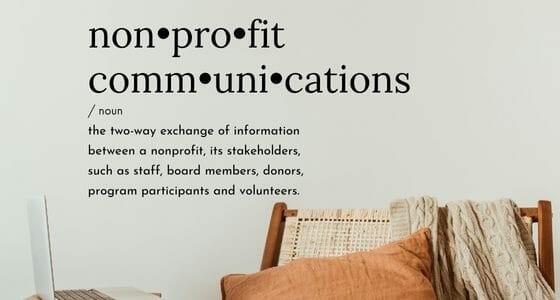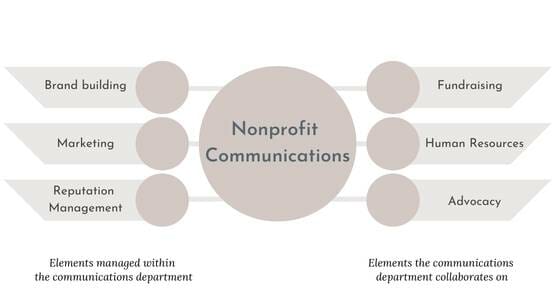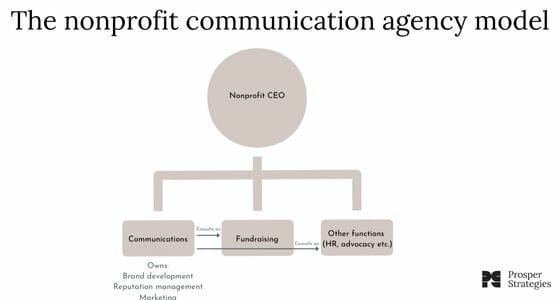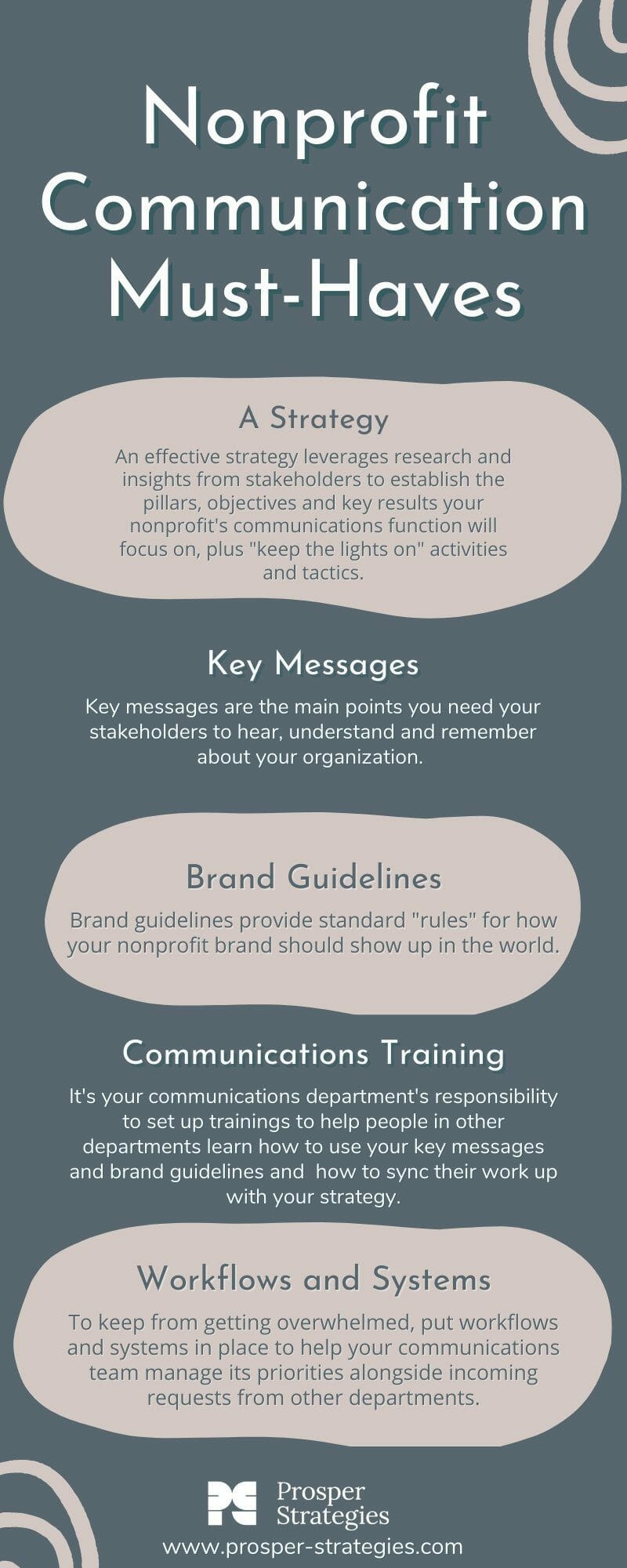What is nonprofit communications anyway?
The answer might seem straightforward at first, but try to define it, and you’ll find that it’s not. The nonprofit sector is full of jargon, silos, and the confusion that both create. Nowhere is this truer than in the nonprofit communications, marketing, storytelling and fundraising arms of organizations, which seem to blur together and overlap more than almost any other area. Ask two different nonprofit professionals what nonprofit communications is and how it relates to these other areas, and you’re likely to get two completely different answers.
That’s a problem because unclear definitions lead to unclear roles, which leads us to working less effectively than we should be for the people and communities our nonprofits serve.
While communications, marketing, fundraising and storytelling are often used interchangeably, I believe each of these functions deserves its own unique definition and attention. We’ll be able to elevate the role that these functions play in the sector if we can move toward a standard definition of each of them and get crystal clear about how they work together.
In this post, we’re taking a closer look at nonprofit communications: what it is, how it differs from other related disciplines, how to structure your communications team, and most importantly, how to master key aspects of nonprofit communications for your organization.
This post includes:
- Definitions for nonprofit communications and related disciplines
- Differences and similarities
- Nonprofit communications team structure recommendations
- Nonprofit communication best practices
- Nonprofit storytelling recommendations
- Nonprofit communication tools and resources
What is nonprofit communications?

Nonprofit Communications is the two-way exchange of information between a nonprofit and its stakeholders, such as staff, board members, donors, program participants and volunteers.
What is nonprofit marketing?
Nonprofit Marketing comprises the activities, touchpoints and messages that motivate stakeholders to take actions that advance a nonprofit’s mission and create sustainable social change.
What is nonprofit fundraising?
Nonprofit Fundraising is the process of soliciting financial support for an organization by building, strengthening and sustaining relationships with individual donors, foundations, corporations and other supporters who are aligned with the organization’s mission and goals.
What is nonprofit storytelling?
Nonprofit Storytelling is the process of sharing accounts, factual and in some cases fictionalized, that depict a nonprofit’s work, impact, mission or vision.
How is nonprofit communications different from marketing, fundraising and storytelling? How are they related?

If you’re still confused, you’re not alone. On the surface, these definitions might sound quite similar, and admittedly, nonprofit communications, marketing, fundraising and storytelling often overlap or work in tandem with one another. Here’s how we like to explain the distinction between them:
Communications is a strategic discipline that can be employed for the purpose of brand building (driving awareness), marketing (driving stakeholders to take action), reputation management (fostering positive perceptions of your organization and cause), fundraising (compelling donors and funders to give), human resources (building an employment brand and fostering a healthy culture), advocacy and more.
Fundraising is an action that takes place when communication is used strategically to get someone to give money to you organization.
Marketing is an action that takes place when communication is used strategically to get your stakeholders to do something (other than give money): volunteer, use a program or service, buy from your social enterprise arm, attend an event etc. Because marketing and communications are so intertwined at many nonprofits, it’s common to see the two elements combined under one strategy and the two terms used interchangeably.
Nonprofit communication is about impacting overall perception while fundraising is specifically focused on driving revenue and marketing is specifically focused on driving action. Effective marketing and fundraising require strong communication to work, but communication can serve other aims, as well.
Storytelling is simply a tool used in various types of nonprofit communications in order to paint a picture of the work your organization does, the impact it has, and its mission and/or its vision. It’s one of many tools in your nonprofit’s communications toolbox, but not the only one.
How should we structure our nonprofit communications team or function?
These definitions and distinctions may raise some questions about how the communications, marketing and fundraising functions of your organization should be structured. Of course, the answer to these questions will depend on your organization’s mission, size and staff makeup, but there are some structures that tend to work better than others. My favorite approach is what I call a “communications agency model.”
This model leans into the idea that communications serves a variety of different aims within a nonprofit, from brand building, to marketing, reputation management, fundraising and even staff retention and engagement. Organizations that employ a communications agency model set up a communications department that is capable of infusing strong communications strategies and approaches into each of these areas.

In a nonprofit communications agency model, the communications department will typically “own” brand development (identity and messaging, etc.), reputation management (public relations and crisis communications, etc.), and marketing (website, advertising, social, email etc). They’ll set and manage their own strategy in these areas, often called a marketing communications strategy or simply a communications strategy.
When it comes to other areas such as fundraising, human resources, or advocacy, the communications department will then function like an agency partner would, treating the other departments or functions as their “clients.” Departments such as fundraising and human resources will operate under their own banners, with their own leaders, but will collaborate closely to build an integrated strategy with the communications department. They’ll also tap the communications team any time their work requires communications skills and expertise. For example, the communications department will help the fundraising team shape the themes and messaging for their campaigns, and they’ll help human resources build a strong employment brand and develop effective internal communications pieces.
While this structure may sound like it’s only a fit for large organizations, we’ve actually seen it work well with communications departments that are as small as 1-5 individuals. It’s effective because it makes it clear the areas that communications “owns” versus the areas that the communications team consults and collaborates on.
One more important note on structure: I am almost always a proponent for keeping communications and fundraising departments separate. Doing so acknowledges that while communications can support fundraising, that’s not the only area communications is concerned with. It also acknowledges that fundraising requires so much more than strong communications to be effective. Of course, there are situations where nonprofit communications, marketing and fundraising all need to come together under one department, and one leader. If that’s the situation at your organization, it’s still important to have separate communications and fundraising strategies, and to then treat the communications function as a contributor to fundraising and other functions, even if the same individuals are working across all areas.
How can we make our nonprofit communications more effective?
While every nonprofit is different, there are a few key things every organization should put in place to ensure the effectiveness of their communications. If you want to keep these elements top-of-mind, download our infographic.

Marketing and Communications Strategy
A marketing and communications strategy is a nonprofit communications team’s most important asset. An effective marketing and communications strategy leverages research and insights from stakeholders to establish the pillars, objectives and key results your nonprofit’s communications function will focus on. It also outlines the “keep the lights on” activities that communications needs to contribute to in order to keep your nonprofit running smoothly, and defines the tactics and tools your communications department will spend its time on. These tactics might include things like:
- Website
- SEO
- Digital and traditional advertising
- Social media
- Events
- Blogging
- Content development
- Direct mail
- Media relations and PR
- Email marketing
In keeping with the definitions above, you’ll want to think about these tactics expansively. Most of them can be used for almost every aim communications serves. For example, email marketing can be used as a touchpoint in fundraising campaigns, as a general brand awareness builder among people not yet engaged with your organization, as a driver to get people to use your programs and services, and as a way to keep employees informed and engaged in your organization’s work. The same “multi-purpose” idea is true of almost every tactic on the list above. If you need more guidance, we have a template for your nonprofit’s marketing and communications strategy available here.
Key Messages
Key messages are the main points you need your stakeholders to hear, understand and remember about your organization. They create meaning behind the work you do, the issues you want to discuss and the actions you want people to take as you work to advance your mission. Your communications team should be responsible for crafting key messages for your organization as a whole, and often for specific programs and initiatives as well.
Brand Guidelines
Brand guidelines provide standard “rules” for how your brand should show up in the world. They define the fonts, colors, visuals, logo treatments and more that everyone at your organization must use when working with your brand, and are often combined with key messages into one, comprehensive document. Clear, actionable guidelines ensure brand cohesion and consistency. Like key messages, your brand guidelines should be owned and managed by your communications department.
Nonprofit Communications Training
Let’s face it: most people on your nonprofit’s team are not natural communicators. It’s your communications department’s responsibility to set up trainings to help folks learn how to use your key messages and brand guidelines, how to sync their work up with your marketing and communications strategy, how to become more effective communicators in their own roles, and how to tap your team for additional expertise.
Nonprofit Communications Workflows/Systems
If you’re going to structure your work using the communications agency model, it’s absolutely essential to have some sort of workflow to help your communications team manage its priorities alongside incoming requests from other departments. If you don’t already have one, consider setting up a project management system (we like Teamwork) where others at your nonprofit can submit “tickets” or work requests from your communications department. Then, vet these requests based on how they align with your overall strategy, and based on your team’s bandwidth. Putting a clear workflow in place will help your communications team from getting overwhelmed and allow you to stay focused on your strategy. It will also make it easier to say no to misguided requests or to put work back onto other departments when appropriate.
How can our nonprofit communications team get better at storytelling?
When I said that storytelling was “simply” a communications tool, I didn’t mean to imply that storytelling is actually simple. Effective storytelling takes effort and practice. Here are a few tips for sharpening this critical tool in your nonprofit’s communications toolbox.
Start with what you already have
Begin by asking your program staff to share stories of the people they interact with every day – they probably have dozens. Then, incorporate those stories into key touchpoints like the homepage of your website, your social media posts and your annual appeal.
Or, consider how you could turn data that already lives in documents like your grant applications or annual report into stories. For example, you might mine data from your annual report to do some social math and describe how you accomplished a specific outcome with a certain amount of funding last year, and how you can increase that impact if you hit your fundraising goal this year. It’s best to pair quantitative data like this with qualitative examples, even if that requires some theoretical/ fictionalized storytelling (ex: “imagine a child who is experiencing homelessness…”) that helps your audience understand the circumstances of the communities and individuals you work with in more general terms.
Cast a wide net
If possible, you should aim to gather stories from as many different types of people your organization works with as possible. This will allow you to take many directions with your communications, paint a more complete picture of the diversity of the populations you serve, and appeal to many different types of donors and other stakeholders.
Ask permission and take a strength-based approach
However you choose to gather stories, make sure that you’re seeking the necessary permissions to use names and imagery, or protecting identities where needed.
You should always plan to run the stories you choose to use by the people and communities reflected in them to make sure they feel comfortable with the way they’re represented. There is nothing worse than exploiting the people you hope to help just to pull on a donor’s heartstrings.
And if you can, you should always take a strength-based approach to telling the stories of the people and communities you serve. One of the best ways to do this is by giving people the agency to tell their stories themselves, in their own words.
More nonprofit communication, marketing and storytelling tools
If you’re looking for more ideas about how to improve your nonprofit’s approach to communications, marketing, fundraising and storytelling, we have many. Check out some of our top picks below.
Now, we’d love to hear from you. How do you define and differentiate communications, marketing, fundraising and storytelling? How do you structure your communications function? What’s working well for your nonprofit when it comes to communications ? Let us know in the comments!





